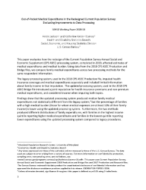Out-of-Pocket Medical Expenditures in the Redesigned Current Population Survey: Evaluating Improvements to Data Processing
Out-of-Pocket Medical Expenditures in the Redesigned Current Population Survey: Evaluating Improvements to Data Processing
Introduction
This paper evaluates how the redesign of the Current Population Survey Annual Social and Economic Supplement (CPS ASEC) processing system, completed in 2019, affected estimates of medical expenditures and medical burden. Using data from the 2018 CPS ASEC Production and Bridge files, we compare family medical expenditures across two processing methods for the same respondent information.
The legacy processing system, used in the 2018 CPS ASEC Production file, imputed health insurance coverage and medical expenditures separately and included limited information about family income in that imputation. The updated processing system, used in the 2018 CPS ASEC Bridge file introduced a joint imputation for health insurance premiums and non-premium medical expenditures, and considered income when imputing both topics.
Findings show that the updated processing system produced median family medical expenditures not statistically different from the legacy system, but the percentage of families with a high medical burden (those for whom medical expenses are at least 10% of their family income) is lower using the updated processing system. Furthermore, the two methods produced different distributions of family expenditures, with families in the highest income quintile reporting higher medical expenditures and families in the lowest quintile reporting lower expenditures using the updated processing system compared to legacy procedures.




